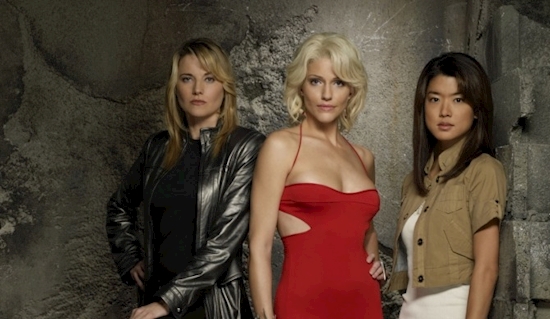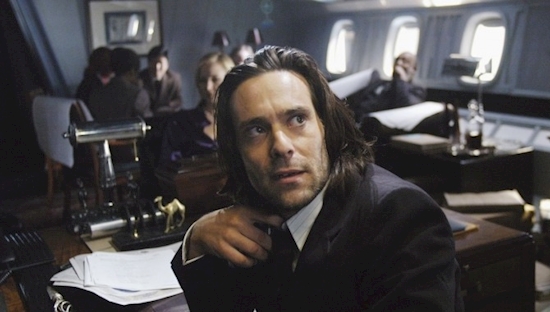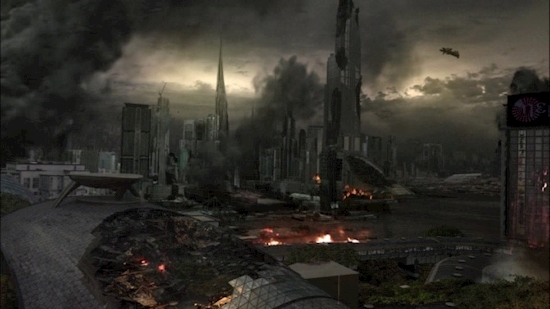The Challenge of Reviving Battlestar Galactica
This article comes from Den of Geek UK.
Warning: contains spoilers for Battlestar Galactica.
Battlestar Galactica sits alongside Stargate, Star Trek, and Doctor Who as one of the biggest sci-fi franchises of the late 20th and early 21st century, sporting an original 1978 series, a 1980 follow-up, a complete reboot starting with a mini-series in 2003 and running for four seasons, and two spin-off series, prequels Caprica and Blood and Chrome.
With the news that a new spin-off in the universe of Ron D. Moore’s Battlestar Galactica is planned, this seems a good time to look at just a few of the things that made it so special.
The Cylons
Perhaps the single biggest change between the 1978 series and the 2003 "re-imagining" is the nature of the Cylons. In the original series, the Cylons were a reptilian race of imperialist aliens who were destroyed by the robots they built to maintain and expand their empire. These robots are what then became known as Cylons, and declared war on humanity. Only one humanoid-looking Cylon appeared, in the sequel Galactica 1980.
In the re-imagining, the Cylons are almost entirely different. They are all artificially created life-forms, but although most are mechanical, some are made from organic material and look almost entirely humanoid, based on thirteen human-looking models. They were originally built, not by an alien race, but by humans themselves, and have rebelled as a result of a combination of mistreatment and religious conviction.
This complete change in the nature of Cylons brought much greater depth to the series. Firstly, there was no alien race (or their robots) attacking and destroying humans – humankind had caused its own near-destruction, and the repetition of the phrase “All this has happened before; all this will happen again” implies that humans are stuck in an endless cycle of hubris and disaster.
Perhaps even more significantly, the existence of human-looking Cylons opened up the "sleeper agent" plots that drove most of the show. Grace Park’s Sharon Valerii was revealed as a Cylon to the audience before "Boomer" realized it herself, and much of the plot during the last two seasons of the show was driven by the question of who the "Final Five" human models were, with no one on the ships entirely sure whether or not they were, themselves, a Cylon. This combination of mystery and thriller in the story arc made for some truly compelling television.
Katee Sackhoff as Starbuck
All of the casting on the show was brilliant – Edward James Olmos as Adama oozes authority, Mary McDonnell as Roslin is his perfect foil, Tricia Helfer is stunning as Six and James Callis is perfectly slimy as Gaius Baltar. The series also pulled in a host of excellent sci-fi veterans for recurring roles including Lucy Lawless, Michelle Forbes, Mark Shepperd, Dean Stockwell, Rick Worthy, and 1978 Battlestar Galactica star Richard Hatch.
The most recognizable face of the show outside of sci-fi fandom, though, was Katee Sackhoff as Starbuck, originally the most controversial piece of casting in it. The character of Starbuck in the 1978 was male, played by Dirk Benedict. Not all fans were happy about the gender swap, not least Benedict himself. However, Ronald D. Moore and David Eick knew what they were doing. A cast as male-dominated as the 1978 cast would not have gone down well in the early '00s, and more to the point, Sackhoff is perfect casting. Her Starbuck is brittle, ambitious, tough, and completely engaging. It’s no wonder she appeared in Howard’s fantasies on The Big Bang Theory (alongside George Takei). She’s currently starring in Netflix’s Another Life in a role that has distinct echoes of her most famous part.
Compelling characters and sharp writing
It doesn’t matter how good your cast is if the writing or characterization is bad, but in Battlestar Galactica’s case, both were excellent. The story was intensely arc-driven – occasional attempts at “filler” episodes didn’t always go so well ("Black Market" is regularly declared to be the worst episode in the series) though sometimes a one-off ended up one of the series’ best hours – the official pilot that followed the mini-series, "33," is one of the show’s best. Overall, though, it was in arc-plotting that the show excelled, keeping audiences glued to their screens as the story moved, and sometimes it moved fast.
The most complex story-arc would be a dull proposition without interesting characters, and the character development on the series, especially in the first two seasons, was excellent. The fairly big cast included a wide range of complex characters. Saul Tigh and Gaius Baltar should, for different reasons, be utterly unbearable but both are compelling and even Baltar is occasionally sympathetic. Early on, Tricia Helfer’s Caprica Six appears to be a rather two-dimensional seductress, but over time, her character is given much more depth and becomes clearly distinguished from the other model Six Cylons. Every disagreement between Adama and Roslin stems from a complicated situation in which the audience can understand both sides, while Starbuck and Apollo’s fraught relationship, although frustrating, feels very real.
On top of all that, throughout the series we follow two characters who start out as the same person but develop into completely different people. Athena knows from the start that she is a Cylon and starts a relationship with Helo; Boomer doesn’t realize at first and pursues a relationship with Tyrol. From these small differences, two completely different characters with different motivations and reactions are built over the course of the show’s four seasons, and both are completely believable. If that isn’t good writing (and acting), we don’t know what is.
It was grimdark TV at a time when that was unusual
We might have reached peak grimdark TV at this moment in time. The biggest dramas on television are series like The Handmaid’s Tale, Chernobyl, Game of Thrones, Peaky Blinders, and Black Mirror. Even comedy-dramas like Orange is the New Black are far from cheerful, and 1990s teen sitcom Sabrina the Teenage Witch has been re-imagined as a dark-tinged comedy-horror. Every major sci-fi franchise can now boast a "darker" and more adult spin-off, from Stargate: Universe to Torchwood, to Star Trek: Discovery.
However, it wasn’t always so. Science fiction and fantasy television in the 1990s was a much brighter, lighter affair – think of shows like Quantum Leap, Lois & Clark: The New Adventures Of Superman, Star Trek: Voyager, or even Buffy the Vampire Slayerin its early years (occasional major deaths notwithstanding). Xena: Warrior Princess dealt with some very dark themes, but usually in a light-hearted manner. For those whose tastes run more to the sunny and optimistic, this was all very well, but other fans hankered for something 'dark' and more serious-seeming.
During the 1990s, Ronald D. Moore worked on three different branches of the Star Trek franchise – The Next Generation, Deep Space Nine, and (very briefly) Voyager. He had the most involvement withDeep Space Nine, which was at the time the 'darker' branch of the Star Trek franchise (Enterprise and Discovery have both aimed at 'darker' content in the years since, though Deep Space Nine has perhaps done so with the most success). Moore left Star Trek after a major falling-out between himself and producer (and his former writing partner) Brannon Braga and a few years later, developed the Battlestar Galactica re-boot with David Eick.
The set-up of Battlestar Galactica, taken from the 1978 original, has clear parallels with those ofDeep Space Nine and Voyager – like the later series of Deep SpaceNine, it is a show about a war, and like Voyager, it follows a group of humans travelling in spaceships, looking for a home. Many fans of Deep Space Nine, which ended in 1999, were disappointed that Voyager was not as dark or story-arc-driven as they had hoped – it is in tone much more like The Next Generation or even the Original Series.
Battlestar Galactica offered those fans a new series that did all the things they had wanted Voyager to do (or that it had not done to their satisfaction) – dealing in serious ways with criminals trapped on spaceships, constant battles with Cylons, intense disagreements about where to go or where to settle, and betrayal from within. With the mini-series premiering two years after Voyagerfinished, and Star Trek: Enterprise not satisfying the desire for "darker" material (despite its best efforts) both disappointed Star Trek fans and viewers simply hankering for something grim and serious flocked to the re-imagined Battlestar Galactica, which gave them everything they were looking for.
It’s hard to imagine that the new series will deviate too much from the tone of the re-imagining. This form of dark, arc-driven story-telling is currently highly fashionable and many fans are still eager for more. A new series that maintains and tight writing and serious themes of the 2003-9 version will fit right in to the current television landscape, and will no doubt be welcome with open arms by old and new fans alike.
Source: www.denofgeek.com




